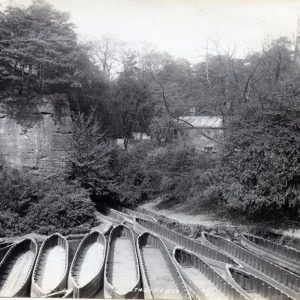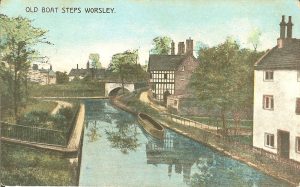Mine boats or M boats, commonly known as starvationers, were built from 1759 to transport first spoil, and then coal, from the Duke of Bridgewater’s underground levelsExtensive network of underground canals that drained the Duke of Bridgewater's coal pits emerge into the open at the Delph in Worsley, Greater Manchester. in Worsley to Manchester via the Bridgewater Canal. They were legged[a]Leggers propelled boats through narrow canal tunnels by lying on their backs on a plank of wood placed across the boat with their feet walking along the tunnel wall. through the underground levels and towed by horses to Castlefield in Manchester.
The mine boats were open to the elements, double-ended with flat bottoms and parallel, vertical sides with exposed frame ribs. Their long, narrow design influenced the design of future narrow boats.
Boats
Mine boats were built to transport coal direct from the coal faces inside the Worsley Navigable LevelsExtensive network of underground canals that drained the Duke of Bridgewater's coal pits emerge into the open at the Delph in Worsley, Greater Manchester. and along the Bridgewater Canal to market in Manchester.[1] They were legged through the underground levels and towed by horses to Castlefield in Manchester. Dry docksEarliest surviving example of a dry dock on Britain's canals. were built on the canal in Worsley, where the mine boats were built and repaired.[2]
Mine boats were built in several sizes, all similarly constructed, open to the elements, double ended with flat bottoms and paralled vertical sides. Their design is the forerunner of present-day narrow boats on British canals. They were typically between 46 feet (14 m) and 55 feet (17 m) long and 4.5 feet (1.4 m) and 6 feet (2 m) wide. They were strongly built with prominent internal ribs that gave them the nickname starvationers. The largest boats were used on the Main Level, they drew 28 inches (71 cm) of water when loaded and 8 inches (20 cm) when empty.[3] The largest could carry around 12 tons of coal or spoil.[1] Mine boats were numbered and a code letter indicated the size. The 10-ton mine boats were letterered M and 7-ton boats were lettered T. Small boats were called tub boats. In 1840 the fleet numbered 75 M boats, 75 T boats and about 100 tub boats.[3] The tub boats, about 30 feet in length and about 4 feet wide capable of carrying just 2 tons, were lowerered vertically down the shafts to access the Lower Level where the shaft bottoms were made elliptical to make the task easier. [3]
Each pit or branch had boatmen responsible for their operation.[3] Convoys of up to 20 mine boats may have been operated by one man, wearing a harness that hooked onto rings projecting from the tunnel walls. He lay on his back on a bench at the end of the boat and legged along the tunnel roof to propel the boat forward.[4] Minor repairs were carried out by carpenters from Worsley Yard while the boats were underground, but heavy repairs required a visit to the dry dock.[3]
Mine boats transported coal directly from deep inside the underground levels out onto the Bridgewater Canal without the need for transshipment. The navigable levels drained the coal measures and kept the Bridgewater Canal in water. A second entrance at the Delph was constructed to avoid congestion in the levels, and more levels were driven to access deeper seams. A subterranean inclined plane, completed in 1795, transported mine boats between levels. The mine boats transported coal until 1887, but were used until the underground levels were abandoned in 1969. A surviving mine boat is preserved at the National Waterways Museum in Ellesmere Port, Cheshire. It is 30 feet (9 m) long and has a 3-foot (0.9 m) beam.[1]


